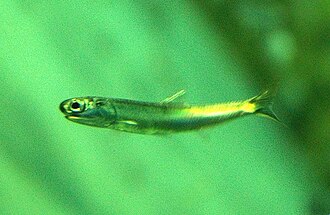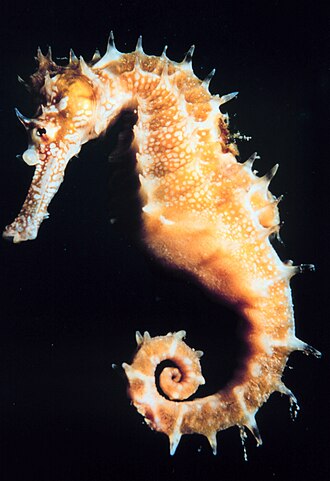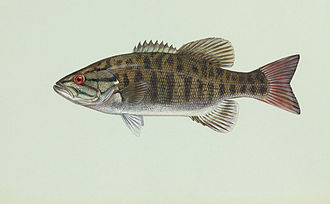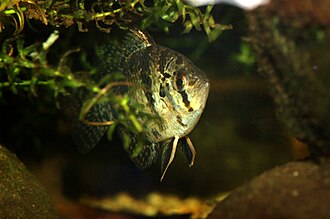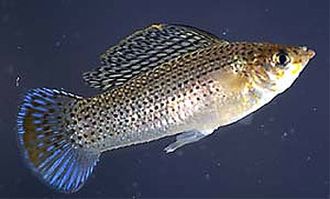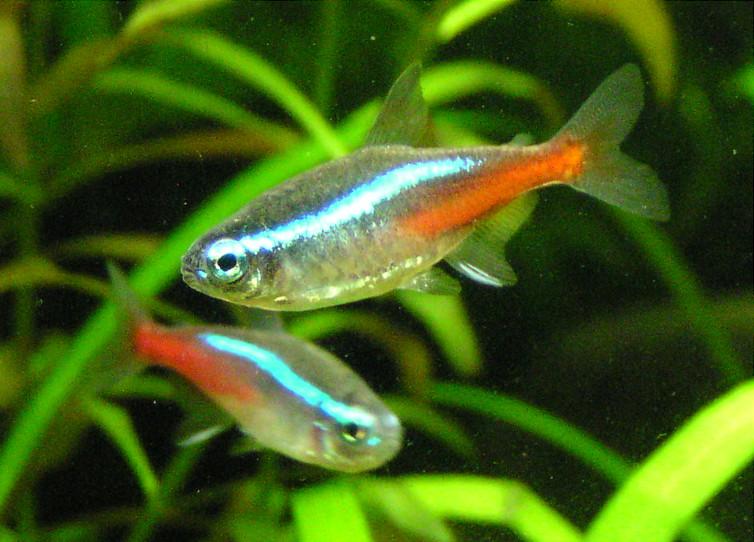Difference between revisions of "AY Honors/Fishes/Answer Key"
| Line 22: | Line 22: | ||
==2. Identify from pictures or personal observation ten tropical fishes.<br> a. Explain their breeding habits.<br> b. Give the habitat or country in which they are found.== | ==2. Identify from pictures or personal observation ten tropical fishes.<br> a. Explain their breeding habits.<br> b. Give the habitat or country in which they are found.== | ||
| + | |||
| + | {{Species id | ||
| + | | common_name = Neon Tetra | ||
| + | | latin_name = Paracheirodon innesi | ||
| + | | image =Neonka obecna paracheirodon innesi.jpg | ||
| + | | caption = | ||
| + | | description = The Neon Tetra has a dark olive-green back over a silver-white abdomen. The fish is characterized by an iridescent blue horizontal stripe along each side of the fish from its nose to the base of the adipose fin, and an iridescent red stripe that begins at the middle of the body and extends posteriorly to the base of the caudal fin. During the night, the color disappears as the fish rests—it reactivates once it becomes active in the morning. It grows to approximately 3 cm (1.25 in) in overall length. Sexual dimorphism is slight, the female having a slightly larger belly. | ||
| + | | range = The Neon Tetra is native to blackwater or clearwater streams in southeastern Colombia, eastern Peru, and western Brazil, including the tributaries of the Solimões. Fish are collected in warm-flowing (21–29°C) clear and blackwater streams, but never in whitewater rivers of Andean origin. | ||
| + | | reproduction = To breed Neon Tetras, place a pair of the species in a breeding tank without any light, and gradually increase the lighting until spawning occurs. Other inducers include mosquito larvae and a hardness of less than 4 degrees. Some also recommend letting the level of nitrates rise, then do at least 50% water change to simulate the fresh rain the tetras get in their natural habitat, the Amazon. It is recommended that everything you place in the aquarium be sterilized, as well as the aquarium top. Because the adults will often eat newly-hatched fry, it is best to remove them as soon as the eggs have been laid. The eggs are especially sensitive to light. Eggs will hatch within 24 hours of the laying. Fry can be fed rotifers, especially infusoria and egg yolk for 1 to 4 weeks, followed by nauplii of brine shrimp, shaved cattle liver, and formulated diets. Fry will achieve their adult coloration at approximately one month of age. Adults can spawn every two weeks. | ||
| + | }} | ||
| + | |||
| + | {{Species id | ||
| + | | common_name = Afra Cichlid | ||
| + | | latin_name = Cynotilapia afra | ||
| + | | image =C afra.jpg | ||
| + | | caption = | ||
| + | | description = The afra cichlid has an elongate body typically with vertical blue and black bars. However, there are many different colorations depending on the region the fish is from, for example, the male fish from Kobwe have greenish stripes on blue-black body. They can grow up to 10 cm. Like many other cichlid from Lake Malawi, afra cichlids are mouthbrooders. Males defend boulders as their territories and feed from algae on those boulders. Females congregate in mid-water and feed from plankton. | ||
| + | | range = This fish is endemic to the central and northern parts of Lake Malawi and is found in rocky habitats. | ||
| + | | reproduction = Like many mbuna cichlids, this is a notoriously aggressive fish that should be kept in a species or mbuna tank. The best practice is to keep one male with several females. They should be provided with large spaces with plenty of hiding shelters. | ||
| + | }} | ||
| + | |||
| + | {{Species id | ||
| + | | common_name = | ||
| + | | latin_name = | ||
| + | | image = | ||
| + | | caption = | ||
| + | | description = | ||
| + | | range = | ||
| + | | reproduction = | ||
| + | }} | ||
| + | |||
| + | {{Species id | ||
| + | | common_name = | ||
| + | | latin_name = | ||
| + | | image = | ||
| + | | caption = | ||
| + | | description = | ||
| + | | range = | ||
| + | | reproduction = | ||
| + | }} | ||
| + | |||
| + | {{Species id | ||
| + | | common_name = | ||
| + | | latin_name = | ||
| + | | image = | ||
| + | | caption = | ||
| + | | description = | ||
| + | | range = | ||
| + | | reproduction = | ||
| + | }} | ||
| + | |||
| + | {{Species id | ||
| + | | common_name = | ||
| + | | latin_name = | ||
| + | | image = | ||
| + | | caption = | ||
| + | | description = | ||
| + | | range = | ||
| + | | reproduction = | ||
| + | }} | ||
| + | |||
| + | {{Species id | ||
| + | | common_name = | ||
| + | | latin_name = | ||
| + | | image = | ||
| + | | caption = | ||
| + | | description = | ||
| + | | range = | ||
| + | | reproduction = | ||
| + | }} | ||
| + | |||
| + | {{Species id | ||
| + | | common_name = | ||
| + | | latin_name = | ||
| + | | image = | ||
| + | | caption = | ||
| + | | description = | ||
| + | | range = | ||
| + | | reproduction = | ||
| + | }} | ||
| + | |||
| + | {{Species id | ||
| + | | common_name = | ||
| + | | latin_name = | ||
| + | | image = | ||
| + | | caption = | ||
| + | | description = | ||
| + | | range = | ||
| + | | reproduction = | ||
| + | }} | ||
| + | |||
{{Species id | {{Species id | ||
| common_name = | | common_name = | ||
Revision as of 23:05, 14 December 2007
Template:Honor header Template:AY Master
1. Name ten families of fishes.
2. Identify from pictures or personal observation ten tropical fishes.
a. Explain their breeding habits.
b. Give the habitat or country in which they are found.
Neon Tetra (Paracheirodon innesi)
Where found: The Neon Tetra is native to blackwater or clearwater streams in southeastern Colombia, eastern Peru, and western Brazil, including the tributaries of the Solimões. Fish are collected in warm-flowing (21–29°C) clear and blackwater streams, but never in whitewater rivers of Andean origin.
Description: The Neon Tetra has a dark olive-green back over a silver-white abdomen. The fish is characterized by an iridescent blue horizontal stripe along each side of the fish from its nose to the base of the adipose fin, and an iridescent red stripe that begins at the middle of the body and extends posteriorly to the base of the caudal fin. During the night, the color disappears as the fish rests—it reactivates once it becomes active in the morning. It grows to approximately 3 cm (1.25 in) in overall length. Sexual dimorphism is slight, the female having a slightly larger belly.
Reproduction: To breed Neon Tetras, place a pair of the species in a breeding tank without any light, and gradually increase the lighting until spawning occurs. Other inducers include mosquito larvae and a hardness of less than 4 degrees. Some also recommend letting the level of nitrates rise, then do at least 50% water change to simulate the fresh rain the tetras get in their natural habitat, the Amazon. It is recommended that everything you place in the aquarium be sterilized, as well as the aquarium top. Because the adults will often eat newly-hatched fry, it is best to remove them as soon as the eggs have been laid. The eggs are especially sensitive to light. Eggs will hatch within 24 hours of the laying. Fry can be fed rotifers, especially infusoria and egg yolk for 1 to 4 weeks, followed by nauplii of brine shrimp, shaved cattle liver, and formulated diets. Fry will achieve their adult coloration at approximately one month of age. Adults can spawn every two weeks.
Afra Cichlid (Cynotilapia afra)
Where found: This fish is endemic to the central and northern parts of Lake Malawi and is found in rocky habitats.
Description: The afra cichlid has an elongate body typically with vertical blue and black bars. However, there are many different colorations depending on the region the fish is from, for example, the male fish from Kobwe have greenish stripes on blue-black body. They can grow up to 10 cm. Like many other cichlid from Lake Malawi, afra cichlids are mouthbrooders. Males defend boulders as their territories and feed from algae on those boulders. Females congregate in mid-water and feed from plankton.
Reproduction: Like many mbuna cichlids, this is a notoriously aggressive fish that should be kept in a species or mbuna tank. The best practice is to keep one male with several females. They should be provided with large spaces with plenty of hiding shelters.
([[w:|]])
([[w:|]])
([[w:|]])
([[w:|]])
([[w:|]])
([[w:|]])
([[w:|]])
([[w:|]])
3. Identify from pictures or personal observation ten fishes native to your own country. Explain their feeding and breeding habits.
4. Define the following parts of a fish:
a. Dorsal fin
A dorsal fin is a fin located on the backs of fishes, whales, dolphins and porpoises, as well as the (extinct) ichthyosaurs. Its main purpose is to stabilise the animal against rolling and assist in sudden turns. Some animals have developed dorsal fins with protective functions, such as spines or venom. Many catfish can lock the leading ray of the dorsal fin in an extended position to discourage predation or to wedge themselves into a crevice. Dorsal fins come in a variety of shapes and sizes.
b. Pectoral fin
The paired pectoral fins are located on each side, usually just behind the operculum, and are homologous to the forelimbs of tetrapods. A peculiar function of pectoral fins, highly developed in some fish, is the creation of the dynamic lifting force that assists, e.g., sharks, in maintaining depths and enables the flight for flying fish.
c. Pelvic fin
The paired pelvic or ventral fins are located ventrally below the pectoral fins. They are homologous to the hindlimbs of tetrapods.
d. Anal fin
The anal fin is located on the ventral surface behind the anus. This fin is used to stabilize the fish while swimming.
e. Caudal fin
The caudal fin is the tail fin, located at the end of the caudal peduncle.
f. Lateral line
The lateral line is a sense organ used to detect movement and vibration in the surrounding water. It consists of a line of receptors running along each side of the fish.
g. Operculum
The operculum of a bony fish is the hard bony flap covering and protecting the gills. In most fish, the rear edge of the operculum roughly marks the division between the head and the body. The operculum is composed of four bones; the opercle, preopercle, interopercle, and subopercle. The morphology of this anatomical feature varies greatly between species. For example, the bluegill (Lepomis macrochirus) has a posteriorly and dorsally oriented rounded extension with a small black splotch present. In some species, the operculum can push water from the buccal cavity through the gills. For some fish, the operculum is vital in obtaining oxygen. It opens as the mouth closes, causing the pressure inside the fish to drop. Water then flows towards the lower pressure across the fish's gill lamellae, allowing some oxygen to be absorbed from the water. Cartilaginous fishes do not have an operculum. Without an operculum, other methods of getting water to the gills are required, such as ventilation.
h. Barbels
The head may have several fleshy structures known as barbels, which may be very long and resemble whiskers.
i. Swim bladder
The gas bladder, or swim bladder, is an internal organ that contributes to the ability of a fish to control its buoyancy, and thus to stay at the current water depth, ascend, or descend without having to waste energy in swimming. It is often absent in fast swimming fishes such as the Tuna and Mackerel families.
j. Gills
The gills, located under the operculum, are a respiratory organ for the extraction of oxygen from water and for the excretion of carbon dioxide. They are not usually visible, but can be seen in some species eg the frilled shark.
5. State briefly the proper care and feeding of fishes of:
a. Tropical zone
b. Temperate zone.
6. Fill an aquarium containing at least five gallons of water with a balance of plants and fishes, either tropical or native, and maintain the same for at least six months.
7. Note the effect of the following on the fishes and aquarium in general:
a. Too much light
During the time that aquarium plants are exposed to light, carbon dioxide is absorbed and oxygen is expelled. The gases enter the plant mainly through the leaves. The carbon dioxide and water are chemically combined with the chlorophyll in the plant to produce simple sugars. The sugars are converted to starch and oxygen is produced as the by-product. The light in your tank is most important with respect to the chlorophyll. The chlorophyll is what absorbs the light to create the process of photosynthesis. The aquarium plant naturally absorbs more nutrients through the roots during this time.
b. Too little light
Respiration is the opposite of photosynthesis. When the lights are out, the photosynthesis process ceases but the respiration continues. The aquarium plant will use oxygen to break down food substances, which is released as energy in the form of heat. Carbon dioxide is produced and expelled as a result of this process. So, when the lights are on the plants absorb carbon dioxide and expel oxygen. When the lights are out the aquarium plants absorb oxygen and expel carbon dioxide.
c. Overfeeding
Overfeeding is one of the major causes of fish loss. Overfeeding promotes fish waste (ammonia) to build up to a harmful level. It is best to feed your betta only enough food that it can eat in five minutes. If food is seen sitting on the bottom of the aquarium or bowl, the fish have been overfed.
d. Excessive change in water temperature
Rapid changes in water temperatures stress your fish. when fish are stressed they are more susceptible to disease and sickness.
e. Too few plants and too many fishes
Fish need plants in the wild for shelter, food, filtration, and oxygen. In an aquarium you supply their main source of food
References
When to use 'fish' or 'fishes'. Use 'fish' when talking about a school of the same species, use 'fishes' when talking about schools of different species. Any time you are talking about more than one species, use 'fishes'. http://www.amonline.net.au/fishes/what/fish.htm
